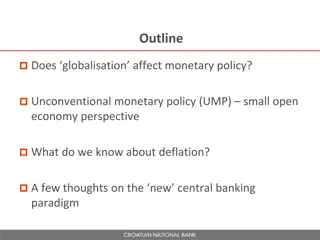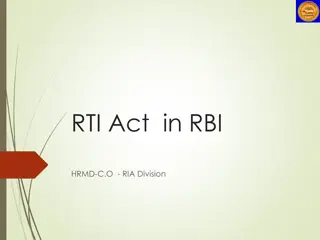Understanding Quantitative Credit Control Methods in RBI's Monetary Policy
RBI's monetary policy revolves around maintaining credit quantity in the market through quantitative credit control methods. This includes Bank Rate Policy, Open Market Operations, Cash Reserve Ratio (CRR), and Statutory Liquidity Ratio (SLR). These tools help regulate credit flow, liquidity, and market stability in the Indian financial system.
Download Presentation

Please find below an Image/Link to download the presentation.
The content on the website is provided AS IS for your information and personal use only. It may not be sold, licensed, or shared on other websites without obtaining consent from the author. Download presentation by click this link. If you encounter any issues during the download, it is possible that the publisher has removed the file from their server.
E N D
Presentation Transcript
QUANTITATIVE CREDIT CONTROL METHODS
MONETARY POLICY OF RBI :- The Monetary Policy of RBI is not merely one of credit restriction, but it has also the duty to see that legitimate credit requirements are met and at the same time credit is not used for unproductive and speculative purposes RBI has various weapons of monetary control and by using them, it hopes to achieve its monetary policy.
I) GENERAL / QUANTITATIVE CREDIT CONTROL METHODS :- In India, the legal framework of RBI's control over the credit structure has been provided Under Reserve Bank of India Act, 1934 and the Banking Regulation Act, 1949. Quantitative credit controls are used to maintain proper quantity of credit o money supply in market. Some of the important general credit control methods are:-
1. BANK RATE POLICY :- Bank rate is the rate at which the Central bank lends money to the commercial banks for their liquidity requirements. Bank rate is also called discount rate. In other words bank rate is the rate at which the central bank rediscounts eligible papers (like approved securities, bills of exchange, commercial papers etc) held by commercial banks. Bank rate is important because it is the pace setter to other market rates of interest. Bank rates have been changed several times by RBI to control inflation and recession.
2. OPEN MARKET OPERATIONS :- It refers to buying and selling of government securities in open market in order to expand or contract the amount of money in the banking system. This technique is superior to bank rate policy. Purchases inject money into the banking system while sale of securities do the opposite. During last two decades the RBI has been undertaking switch operations. These involve the purchase of one loan against the sale of another or, vice-versa. This policy aims at preventing unrestricted increase in liquidity.
3. CASH RESERVE RATIO (CRR):- The Cash Reserve Ratio (CRR) is an effective instrument of credit control. Under the RBI Act of 1934 every commercial bank has to keep certain minimum cash reserves with RBI. The RBI is empowered to vary the CRR between 3% and 15%. A high CRR reduces the cash for lending and a low CRR increases the cash for lending.
4. STATUTORY LIQUIDITY RATIO (SLR):- Under SLR, the government has imposed an obligation on the banks to maintain a certain ratio to its total deposits with Bank itself in the form of liquid assets like cash, gold and other securities.
5. REPO AND REVERSE REPO RATES In determining interest rate trends, the repo and reverse repo rates are becoming important. Repo means Sale and Repurchase Agreement. Repo is a swap deal involving the immediate Sale of Securities and simultaneous purchase of those securities at a future date, at a predetermined price. Repo rate helps commercial banks to acquire funds from RBI by selling securities and also agreeing to repurchase at a later date. Reverse repo rate is the rate that banks get from RBI for parking their short term excess funds with RBI. Repo and reverse repo operations are used by RBI in its Liquidity Adjustment Facility RBI contracts credit by increasing the repo and reverse repo rates and by decreasing them it expands credit.























